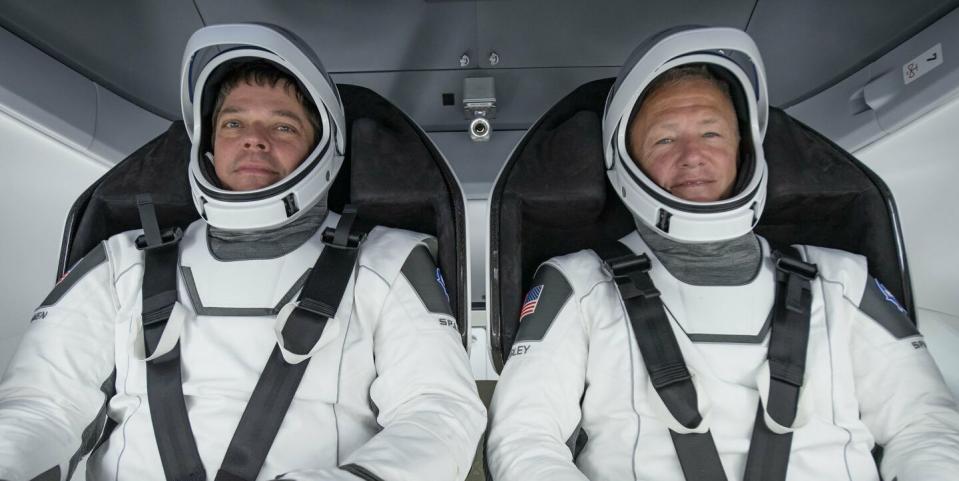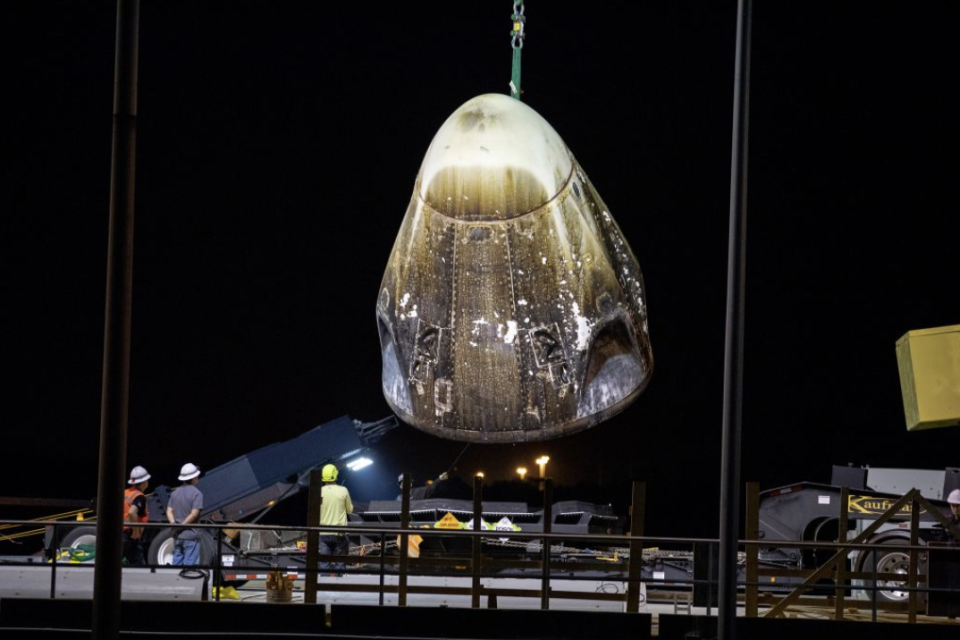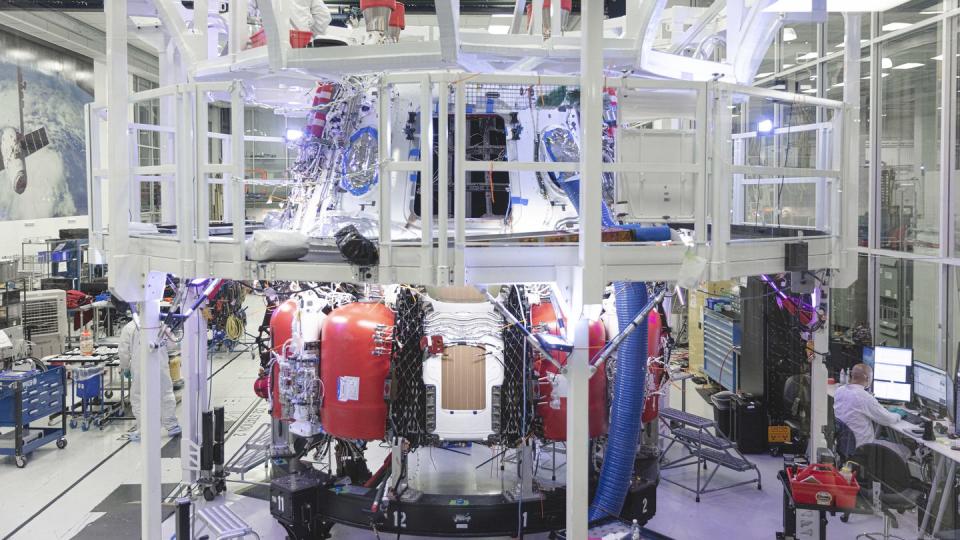This Week's SpaceX Launch Begins a New Era of Spaceflight

For the first time ever, SpaceX will launch a crewed mission to the International Space Station this Wednesday. If all goes according to plan, NASA astronauts Bob Behnken and Douglas Hurley will take the helm of the company’s Crew Dragon spacecraft and shepherd it into a new era of space exploration.
"I think we have pounded the issues associated with falcon and dragon more than any other mission we've had in our history leading to here," SpaceX President and COO Gwynne Shotwell said in a press conference earlier this month.
Yesterday, NASA and SpaceX wrapped up a final flight readiness review meeting, meant to pick apart each step of the mission with a fine-toothed comb. NASA and SpaceX conducted a final static fire on Friday and Behnken and Hurley donned their spacesuits for a final dress rehearsal on Saturday. Barring a weather delay—as of May 26, the weather forecast stands at 60 percent "favorable"—the mission has been cleared for launch.
.@NASA and @SpaceX managers are gathered for day two of the Flight Readiness Review for the upcoming Crew Dragon mission to the @Space_Station. 🚀
Teams are expected to complete the review today and then hold a news conference ~one hour after the review: https://t.co/8sWE16ZStg pic.twitter.com/PLGSLxBRi4— NASA's Kennedy Space Center (@NASAKennedy) May 22, 2020
This launch is the culmination of a long partnership between the U.S. space agency and Elon Musk’s SpaceX, which was founded back in 2002.
NASA first took a chance on SpaceX in 2006 when the agency—desperate to find a new way to ferry crew and cargo to the ISS—awarded the up-and-coming aerospace company with a Commercial Orbital Transportation Services contract. (Orbital Sciences, which develops the Cygnus spacecraft, also received a contract.)
Since then, SpaceX's Dragon vehicle has docked with the International Space Station 21 times, ferrying everything from experiments that grow sections of the human gut on a microchip to barley that could eventually be used to brew beer in microgravity. The company has developed and launched numerous reusable Falcon 9 rockets and has ambitions to ferry humans to the moon and Mars.
Over the years, NASA has continued to place its faith in the company. Just this month, the agency award SpaceX, alongside the aerospace company Dynetics and Jeff Bezos’ spaceflight company Blue Origin, a contract to build a Human Landing System for the upcoming Artemis mission.
"We've obviously been pleased by [NASA's] financial support, their technical support, wisdom and knowledge in helping us get to this day," Shotwell said, referring to the upcoming May 27 launch.
A Rocky Road

But as anything related to spaceflight, there were challenges and setbacks.
SpaceX had initially planned to send a crew into orbit in 2017. There were explosions, failed parachutes, ballooned costs, and significant delays. The company lost two Falcon 9 rockets and a Crew Dragon capsule which exploded during a 2019 ground test. (Boeing, with whom SpaceX shares a Commercial Crew Contract, has had an even tougher go at it.)
But last May, an uncrewed Crew Dragon vehicle successfully docked with the ISS and returned to Earth. In January, the company nailed an in-flight abort test where they jettisoned the crew vehicle from its falcon rocket mid-flight.
Shotwell said during the press conference that SpaceX is already working with other astronauts as they train for the upcoming Crew-1 mission, which is scheduled to launch later this year. The international mission will feature Japan Aerospace Exploration Agency’s Soichi Noguchi.
Once Demo-2 is complete, and the SpaceX and NASA teams have reviewed all the data for certification, SpaceX will launch Crew Dragon’s first six-month operational mission (Crew-1) later this year. The Crew-1 spacecraft is in production and astronaut training is well underway pic.twitter.com/SVMQMkK6AB
— SpaceX (@SpaceX) May 1, 2020
As we’ve steered closer and closer to a future propelled by the private space industry, critics have lamented that interlopers like SpaceX and Blue Origin could unseat the titans of aerospace engineering like Lockheed Martin and Boeing. The shifting tide toward privatization in space has been difficult for many in the industry to swallow.
On a Budget

One thing is clear, NASA has saved a ton of money investing in its Commercial Crew program. According to a report by The Planetary Society, NASA has funneled around $7.6 billion dollars into its Commercial Cargo and Crew program. That investment is paying off.
At $1.7 billion dollars, SpaceX's Crew Dragon vehicle is the least expensive spacecraft developed since the Mercury Program, which, adjusted for inflation, cost the agency $2.7 billion. The most expensive spacecraft, the Apollo command and service module, set the agency back by $30 billion. (Boeing's Starliner CST-100 vehicle, according to the report, comes in at around $2.8 billion.)
And then there's the actual cost of putting butts in seats. Since the last space shuttle launched in 2011, NASA has been purchasing seats aboard Russia’s Soyuz spacecraft for about $90 million a pop. By comparison, a seat aboard Crew Dragon costs anywhere from $60-67 million, according to the Planetary Society. And a ticket aboard Starliner CST-100? That'll cost more than Soyuz, between $91-99 million. (Roscosmos has griped about SpaceX driving costs down.)
NASA's early investment in the company paved the way for a new era in space exploration. "Because of the investments NASA has made in SpaceX, the United States of America now has about 70 percent of the commercial launch market, Bridenstine said during the May 1 press briefing. "That is a big change from 2012, when we had exactly zero percent."
"For all of humanity"

Bridenstine hopes the benefits of these investments (and this mission) will extend not just to the U.S., but across all of humanity. Experiments conducted in microgravity have provided untold insight into the workings of the human body and the universe.
"These are things that have been transformational for humanity and really enable the commercial marketplace to form in space," Bridenstine continued. "In order for that to be successful, we need to have the capability of accessing space not just for NASA but for all of humanity."
The Demo-2 mission is a critical first step in making space more accessible and data collected during the flight will serve to inform future missions down the line. "We want to learn from everything we do and apply it wherever we can—to be more safer, to be more reliable, to be more efficient and, ultimately, to be able to take lots and lots of people into space," SpaceX Director of Crew Mission Management Benji Reed said in a May 22 press conference following a flight readiness review meeting.
The ultimate goal, Bridenstine has said, is for NASA to become one of SpaceX and Boeing's many customers, like a budget traveler scooping up cheap seats on a discount airline. In the past, the administrator has waxed poetic about turning low-Earth orbit into a bustling metropolis. Private space firms develop—and, critically, fund—their own space stations that legacy space agencies can use to breakdown the myriad challenges of spaceflight.
If all goes well, this week's launch will inch us a tiny bit closer to that future.
You Might Also Like

 Yahoo News
Yahoo News 